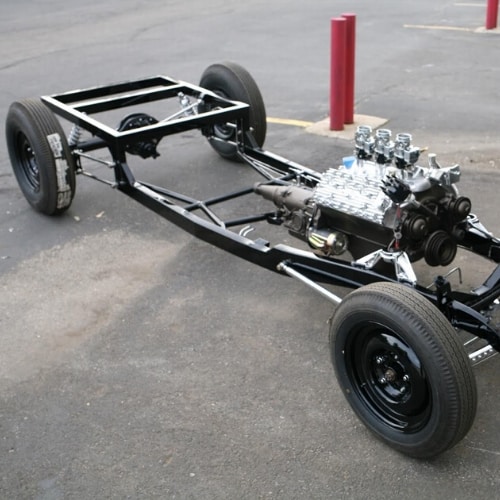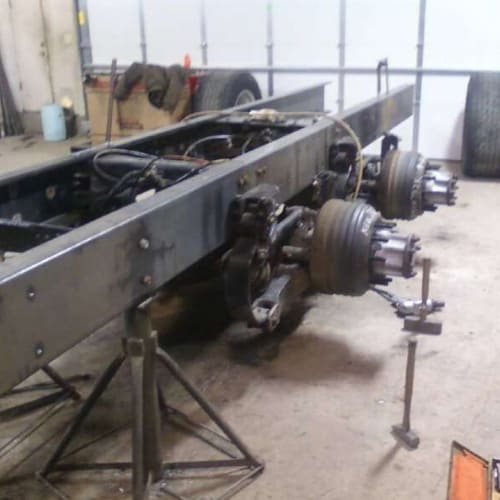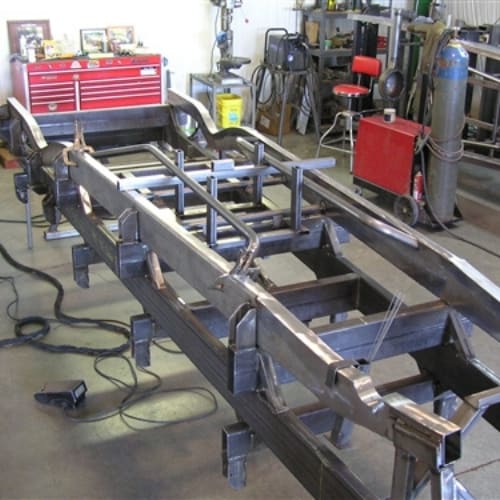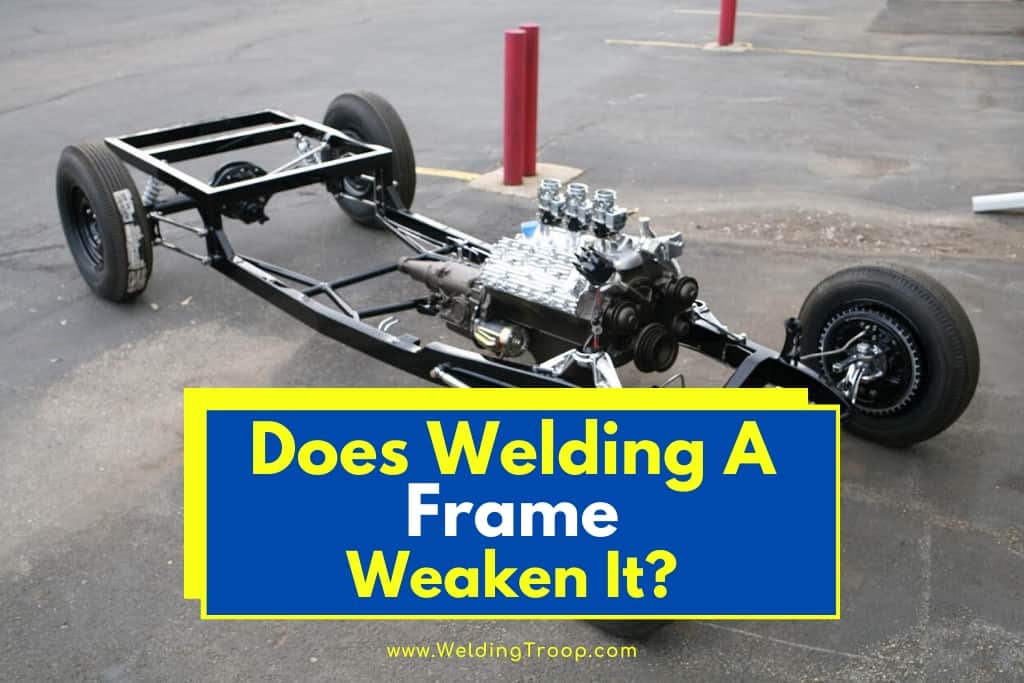Over 50% of man-made products like cars, planes, trains, and buildings that we live in have foundations that require some form of welding, in cases also frames. The overall strength of welding frames is questionable, especially once a frame has been broken.
Does welding a frame weaken it? Depending who you speak to, they will tell you welding a frame, especially for vehicles, will weaken it. However, adversely other people will tell you welding a frame will strengthen the foundation, but ultimately it depends on the type of weld used.
There are several welding techniques, and some create a stronger bond, which is dependent on the type of metal and substrate used to weld.
Each welding technique has its own advantages and disadvantages compared to other styles. They are all unique in their own way and better in different fields.
Table of Contents
Welding Frames
Welding is essentially the joint of two metals through a localized application of a combination of metallurgical, pressure, and temperature. This is used in just about every industry.
By principal welding is the means of repairing and fabricating metal products. Additional material is added to allow the joint of materials to flow to be joined to build a strong bond.
Now, welding on any vehicle frame should be performed carefully. Welding larger commercial vehicles like buses or semi-trucks that travel on highways is technically not lawful in most cases. There are strict regulations due to safety issues.
Once any vehicle is re-welded or has frame issues or the rails have been cut, it should no longer drive on a highway and would have to be registered as off-highway only.
Welding is popular in automotive manufacturing. There are different types of welds for different parts of the vehicles.
These welds were particularly used to create strong bonds for connecting parts and building frames.

Automotive Industry
A common industry that uses welding extensively is the automotive industry.
Welding techniques that are in the automotive industry includes the more popular resistance spot welding, metal inert welding, resistance seam welding, tungsten inert gas, laser beam, friction, and plasma arc welding.
In automotive production with regards to welding, each added metal increases that weight of the vehicle, which in return will make the fuel efficiency less.
There are certain welding techniques that reduce this weight increase. Two of those techniques include medium frequency welding (MFW) and magnetic pulse welding (MPW).
Frame Repair: Fixing a rusted/cracked truck frame >> Check out the video below
Medium Frequency Welding
Medium Frequency Welding is a type of welding that uses resistance. It uses an AC current and supplied through an inverter to convert current to frequency to a higher, medium frequency and goes through a transformer which is using a welding gun.
The benefits of medium frequency ending include a cleaner weld, more efficient, faster welding process, and more materials to choose from.
In this industry, many combinations of welding techniques are used to build vehicles. There is a constant search for lighter weight welds with stronger holds to create better fuel-efficient vehicles.
Related reading: What’s The Difference Between AC And DC Welding >> AC vs. DC
Magnetic Pulse Welding (MPW)
Magnetic pulse welding is a process that uses lighter materials such as aluminum. The overall goal of this process is to achieve a lighter and more fuel-efficient vehicle.
The manufacturing companies have a high demand for improving the quality for these vehicles.
The issue on Weakened Frames
The issues where welds are thought to weaken frames is when the initial frame cracks and is rewearing. It ultimately depends on how bad the damage the crack caused and if it is repairable.
Some people weld vehicle frames by using spot welding. This is a common welding technique that is known to be efficient.

Where safety protocols will suggest welding a broken frame is not ideal on your own, but it can be done. The question if it will weaken your frame is dependent upon the type of weld and how well the process is done properly.
Just keep in mind the laws and regulations that are placed for welding frames.
Related reading: 11 Common Welding Defects and How to Prevent Them
Is It Safe to Weld a Truck Frame?
If you have an older truck, there is probably a chance that some things are starting to go wrong with it.
Most items that malfunction are generally related to things under the hood and can easily be repaired or replaced, for the right cost.
However, if you notice cracks in the frame of the body on your truck, the answer to fixing your problem is not so easy.
Is it safe to weld a truck frame? No, it is not safe to weld a truck frame. While experienced shops and welders may be able to repair a cracked truck frame using welding techniques effectively, a novice welder will not be able to weld a truck frame satisfactorily, likely making the frame weaker in the process.
It is possible to weld a cracked and rusty truck frame in a way that makes it look good, but that does not necessarily mean that the frame is safe to support the weight of the truck.
When considering that a truck may go at high speeds, over bumps, and possibly get into accidents, an undermined frame can lead to serious consequences, and a welding job is not to be trusted.
Common Problems in Truck Frames
There are a couple of common issues that occur with truck frames that are usually caused by fatigue, stress, poor workmanship—or a combination of all three.
Bending
Bending is when the frame permanently changes shape. Bends are caused by static overload from too much cargo impact or impact from dropping a load onto the cargo body. Bent frames will often be seen in car accidents.
Cracking
Frames can sometimes crack as the result of fatigue, high-stress levels, and, in many cases, poor workmanship. When the crack is between the axles, it usually starts in the bottom flange and then moves upward through the web.
While both bent and cracked frames can be repaired at auto body shops, the repairs are not cheap, with insurance companies often electing to total the truck as opposed to going through the expensive and time-consuming process of repairing the frame.
Furthermore, even in instances in which the frame is properly repaired, many users note that the vehicle is never really the same, with notable differences in performance and handling detected by drivers.
As such, it is often recommended that owners simply scrap their truck out for parts and get a new truck rather than attempt to repair the frame.
Related reading: I have recently written an article in which I describe Physical weld Testing in more detail, read this article here: Physical Weld Testing – Ultimate Guide – Destructive & Non-destructive
Challenges of Welding Truck Frames
Welding a cracked truck frame may seem like a simple and straightforward fix to solving your frame issues, but there is much more than meets the eye.
The following are some common issues that arise, making it unsafe to weld truck frames:
- Lack of penetration presents a safety risk. A strong truck frame should consist of one solid piece of metal. The issue with many welds, especially those performed by novices, is that they join the bases only at the surface. This provides little benefit when the frame is put under significant stress.
- Most welders do not have sufficient control. To properly weld a truck frame, a priority must be placed on control. This is important not only on the part of the welder but in support of the frame during the process. Therefore, the only truly effective truck frame welds take place in the original manufacturing plant under the most controlled conditions.
- Poor welds actually weaken a truck frame. A poor weld can lead to the failure of a truck frame, as welded frames are 80 percent more likely to fail at the point of a weld than a solely constructed frame.

What to Do When Welding a Truck Frame
Despite the overwhelming evidence that welding truck frames, especially those welds undertaken by amateurs as a means of a convenient fix to truck frame issues, is not safe, there will still be some who try to weld their cracked truck frames, anyway. If this is the case, consider the following steps:
- Do not go from stiff to flexible in the frame’s construction. Any sudden change in the frame’s constitution will cause weakness to be magnified. Taper and stagger reinforcements to distribute the repair over a larger area.
- Match steels for yield strength as closely as possible. Use the lower yield for calculations to give yourself the greatest possible room for error to determine if the welded frame will be able to support the truck’s payload.
- Extend reinforcements a minimum of twice the frame height past the weld before beginning the taper. This provides the greatest safety net and maximizes reinforcements.
- More steel is stronger than less steel. Simply put, do not try to skimp on materials when attempting to weld a truck frame.
- Be as thorough as possible with your preparations before starting the weld. Adequately study all manufacturer designs and have a complete plan of attack on what the final frame should look like, the welding process you plan on using, and what your contingency plan is in the result that any issues would arise.
- Practice the process you are going to use on the truck frame before starting the weld. Do not attempt to weld the truck frame until you are confident in your process and experienced enough to perform the weld in a real situation.
(Source: Versa Lift East)
Concerns when Driving on a Welded Frame
Welding a cracked truck frame may look good, and, in some cases, may even be considered “successful.” However, there are a couple of factors to consider before putting a welded frame out on the road.
Legality
In some cases, it is simply illegal to drive a vehicle with a welded frame on public highways. Title 49 of the Federal Motor Carrier Safety Administration (FMCSA) states that “no holes shall be drilled into the top or bottom of rail flanges, except as specified by the manufacturer.”
As such, many vehicle frames that have been cut, welded, drilled, modified, or repaired in any way may be deemed in violation of this FMCSA code, making them illegal for use on public roadways and restricted to private, off-road purposes.
If you are caught driving a vehicle with an improperly welded frame on the highway, it can lead to some serious penalties.
Liability
In the event of an accident, if the cause is traced back to an after-market weld job in the vehicle’s frame, the person who welded the frame may be looking at liability in civil court.
Moreover, some insurance companies will not carry vehicles that have welded frames, further complicating matters in the event of an accident.
Are There Other Ways to Repair a Damaged Frame?
Generally, when a frame becomes damaged, the vehicle becomes unsalvageable, as the crack is generally the result of such a traumatic force that the vehicle has been totaled, or the frame has rusted and degraded to the point that the crack is just the first of many subsequent frame issues.
Some in the field have suggested that a bracing system is more effective in repairing cracks in the truck frame, with a bolt and metal brace used to secure the compromised area of the frame.
However, like with a welding job, this bracing system provides dubious reinforcement for a compromised truck frame and should only be attempted by a professional.
All in all, the following final guidelines should be followed when considering welding a truck frame:
- As a quality frame repair will cost around $10,000, it is only worthwhile to consider for vehicles new enough to maintain value greater than this.
- Only professional body shops with extensive experience should be trusted with truck frame welds.
- Know your state’s laws regarding driving vehicles with repaired frames.
How Much Does It Cost To Weld a Truck Frame?
Your truck’s frame may be damaged due to various reasons such as fatigue, stress, poor workmanship, or an accident.
Even though welding your frame is sometimes less expensive than replacing your car, you should think twice.
Most professional welders would tell you that a compromised truck frame can be a potential hazard and a danger to yourself and others on the road.
Once you have a bent or cracked frame, you should seriously consider scrapping the vehicle. Due to the weight of a truck and uneven road surfaces and the stress of larger loads, welds in the frame may be weak points and be dangerous.
How much does it cost to weld a truck frame? If you are, however, determined to have your truck frame welded, you are looking at an average of 10,000 dollars depending on the severity of the damage.
Payscale states an average welder rate in the USA is $18,27p/h, but each job, welding style, and materials have variable prices.
Related reading: I recently wrote an article in which I talk in more detail about the salary of welders, read this article here: “Do Welders Make Good Money – Highest Paying Welding Jobs“
If you wish to weld your truck frame, you would need a very experienced welder, and the hourly rates would increase substantially.
Bear in mind that many welders would not take a frame weld job due to potential liability in frame weld failure related damages.
There are some legal stipulations in the Federal Motor Carrier Safety Administration Title 49: Subtitle B: Chapter III: Subchapter B: Part 393.201 (d) regarding the legality of operating vehicles with bolted, notched, or bent frames being prohibited except by manufacturer recommendation.
How Much Does It Cost To Fix a Cracked Truck Frame?
How much does it cost to fix a cracked truck frame? Cracks caused by rust are expensive due to the time and labor necessary to restore the area to be fixed and range into the 3,000 dollar mark.
However, the cost of fixing a cracked truck frame depends on which area has been cracked, the fracture’s extent, and its nature.
Hairline fractures are less costly to repair, whereas extensive cracks might be:
1) Illegal to repair and then operate on the roads according to Federal Motor Carrier Safety Administration Title 49: Subtitle B: Chapter III: Subchapter B: Part 393.201 (d)
2) Be illegal to sell without notifying the buyer of the frame repairs
3) Depending on the nature of the crack and value of the car, it may be a safer and more cost-effective idea to scarp the vehicle
Are You Allowed To Weld Subframes?
It is not advised to weld subframes corroded through to the lower suspension arms mounting points because this would decrease the structure’s strength.
The subframe of a vehicle falls into the category of a highly stressed component, so repairs or welds may nor guarantee that the frame will be its original strength.
A coded welder may be skilled enough to repair a subframe might be able to fix the area enough to pass inspection, but the costs of such skilled operation will be high.
Highly stressed components such as the subframe should not be repairs if the corrosion has reduced its thickness or caused a hole or a split. Doing so might endanger oneself and others on the road.
Depending on the severity of the damage to your subframe, it may be a risk to repair such a critical component of your car.
Will Welding On A Vehicle Damage Electronics?
Will welding on a vehicle damage the electronics? The simple answer is yes; welding may damage your electronics if the welder does not take the necessary precautions during welding. However, there are many conflicting answers regarding welding on vehicles and resultant electronic damage.
With modern onboard computerized technology, it is no longer easy to conduct welding on a vehicle without causing electronic damage due to contemporary car manufacturers’ design decisions.
Before you begin any repairs such as welding, you need to consult your owner manual and your vehicle’s manufacturer before beginning any repairs that affect electrics. Once you have done that, ensure:
- Always disconnect the negative battery terminal from the vehicle to open the electrical circuits to your vehicle battery. This disconnection reduces the risk of overvoltage damage.
- Place the welding ground clamp as close as [possible to your welding arc to reduce the electrical path between your arc and the ground
- Disconnect your airbag plugs under the vehicle hood
- You may elect to disconnect your vehicles ECU bust this carries its risks such as disruption to the OBD2 system and is not advised
Should I Disconnect The Car Battery When Welding?
Ensure that your negative battery is disconnected when you intend to weld on your vehicle. When your negative terminal is disconnected, the loop is broken, and both terminals of the ECU will float to the same voltage and prevent overvoltage damage.
Electrical current may cause damage to your electrical circuits. Also, ensure that all modules, batteries, sensors, and electric components are removed from the welding area.
How Do I Check For Frame Damage?
When buying a second-hand car or inspecting your vehicle for frame damage after an accident, you should look for these five signs:
- Visible damage or bending. Look around and under your car for creases, cracks, or rust
- Your vehicle is not running in alignment. If your car is pulling in one direction even after having the wheel alignment done, you may have a damaged frame
- Unusual noises. Frame damage can result in strange squeaking or creaking noises from different areas of your car
- Uneven wear on suspension or shocks. Damage to your frame will cause uneven weight distribution and this will show as uneven wear on your vehicle especially in your tires
- Other parts are not fitting flush. Frame damage can cause other parts of your car to move out of alignment, such as doors, windows, and mounts.
How Do You Protect Your Gas Tank When Welding A Truck Frame?
Empty gas tanks have a combination of fumes and oxygen that are highly flammable.
It is always recommended that you take extreme caution when welding around any flammable source. It is best to drain your tank and run a pipe off the exhaust to drain the last of your gas.
You will then need about 20 minutes of exhaust fumes to purge the tank then cover the tank to protect the plastic. Otherwise, removing the tank is the safest bet, ensuring no exposed pipes or leaks.
Related Article: Personal Protective Equipment for Welders – PPE | List, and Requirements
Types of Welding Techniques
Resistance Spot Welding (RSW)
The principle of resistance spot welding is produced by heat generated from the resistance of work pieces to the flow of current with the application of pressure.
This technique is not continuous due to the limit of spots the work pieces can be overlapped.
This welding process uses copper electrodes to conduct a welding current. The application of pressure ensures a strong bond between work pieces.
Stick Arc Welding
Stick arc welding is the type of welding that uses a consumable electrode that gives an electric current.
When the electrode contacts the metalwork price, an electric arc is created at the gap generating an incredible temperature of high heat.
This temperature reaches 6500 degrees Fahrenheit. This heat melts the electrode creating the weld.
Thin metals can be weakened using this style of welding. This would not be ideal for welding frames if the initial metal work piece is especially thin. It is better on thicker metals.
Working with his type of welding technique takes a lot of skill.
Related reading: Stick Welding: Ultimate SMAW Guide You´ll Ever Need
Metal Inert Gas Welding (MIG)
Metal Inert Gas Welding uses a gun with a continuous feed of consumable electrodes. This technique uses an external gas to shield the welded metal from oxygen.
Welding metals for this include aluminum, magnesium, nickel, and copper. It is used in automotive repairs, fabrication, and robotics.
Resistance Seam Welding
Resistance Seam Welding is the type of welding when a joint is produced progressively along the length of a weld. This welding process is continuous and ideal for welding tight joints in sheet metal.
In the automotive industries, this technique is primarily used to create leak-proof fuel tanks.
Tungsten Inert Gas (TIG)
Tungsten Inert Gas welding is the process of melting two pieces of metal together without any filler or additional material. This technique requires a lot of experience and high skill.
This type of welding does not work on rusty or dirty materials.
It is important to understand these different welding techniques because, like the tungsten inert gas weld, it would potentially weaken a frame if the material is slightly rustic and not clean thoroughly.
However, TIG is best for aerospace and vehicle manufacturing, including motorcycles.
Laser Beam
Laser beam technology has many advantages, which makes it popular in the automotive industry. It has high flexibility, low maintenance, and energy savings, all while giving a strong bond.
This technique uses heat generated when a focused laser beam makes contact with the joint.
There is a specific size of metal that works better with laser welding. That range includes 0.2-6 mm.
Friction Welding
Friction welding is the application of welding when the joint is produced by the application of pressure without any significant melting of work parts.
It is a solid-state weld, which means the heat is obtained mechanically. Heat is created when the two metal parts are sliding against one another, creating friction.
The two pieces of metal are held together under pressure. This combination is controlled by regulating the speed of the rotation of parts sliding against each other, time, and pressure.
In the automotive industry, friction welding is used on hydraulic cylinders, piston rods, and engine valves.
Plasma Arc Welding
Plasma arc welding is quite similar to TIG as the arc is created between a tungsten electrode and a workpiece. A plasma arc can be separated with a gas shield and forced through a fine copper nozzle that constricts the arc.
This technique is capable of working on materials with surface contamination or deficiencies. A disadvantage to this welding method is that the torch is heavy and makes welding more difficult.
If you are interested in welding gear or tools, then just follow the link to our recommendation page where you can see all welding accessories we love and use (NO CRAP)
+ Highest Quality
+ Tested & Approved
+ Affordable Machine
+ Right Balance Between Quality & Price
Source:
https://www.ijmer.com/papers/Vol4_Issue9/Version-4/C0409_04-1319.pdf
https://www.diychatroom.com/f46/can-i-weld-truck-frame-mig-welder-96076/
Welding up the 240Z Chassis >> Check out the video below


